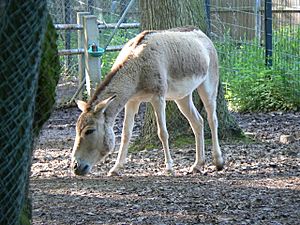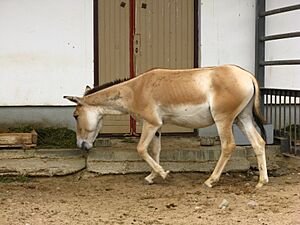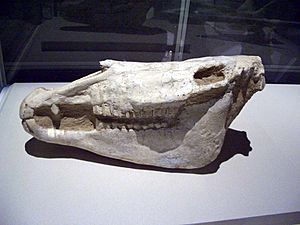Turkmenian kulan facts for kids
Quick facts for kids Turkmenian kulan |
|
|---|---|
 |
|
| A Turkmenian kulan at Wildpark Pforzheim. | |
| Conservation status | |
| Scientific classification |
|
| Kingdom: | Animalia |
| Phylum: | Chordata |
| Class: | Mammalia |
| Order: | Perissodactyla |
| Family: | Equidae |
| Genus: | Equus |
| Species: | |
| Subspecies: |
E. h. kulan
|
| Trinomial name | |
| Equus hemionus kulan Groves & Mazák, 1967
|
|
| Synonyms | |
|
Equus hemionus finschi |
|
The Turkmenian kulan (Equus hemionus kulan) is a type of wild ass. It is also known as the Transcaspian wild ass or Turkmenistani onager. These animals live in Central Asia. In 2016, they were listed as an Endangered animal.
The number of Turkmenian kulans has been going down in their home country. But their numbers are slowly growing in places where they have been moved to. These places include Kazakhstan and Uzbekistan. They have also been moved to Israel. Here, they are mixing with Persian onagers in the wild.
In 2005, there were about 1,300 kulans in Turkmenistan. Today, it is thought that over 6,000 kulans live in Central Asia. In 2017, about 3,900 kulans lived in Kazakhstan. Most of these, about 3,400, live in Altyn-Emel National Park.
Contents
Physical Features of the Turkmenian Kulan

The Turkmenian kulan is one of the biggest kinds of onagers. It can be 200 to 250 centimeters (about 6.5 to 8 feet) long. It stands 100 to 140 centimeters (about 3 to 4.5 feet) tall at the shoulder. These animals weigh between 200 and 240 kilograms (about 440 to 530 pounds). Male kulans are usually bigger than females.
The Transcaspian wild ass has a pale brown coat. It has a dark stripe running down its back. Its sides, back, and belly have white patches. It also has a shaggy black mane and a tuft of hair at the end of its tail. In summer, its coat is thinner and brown. In winter, it grows a thick, grayish-brown coat to stay warm.
Evolution of the Kulan
The group of animals called Equus includes all modern horses, donkeys, and zebras. Scientists believe they came from an older animal called Dinohippus. One of the oldest known species is Equus simplicidens. This animal looked like a zebra with a donkey-shaped head. The oldest fossil found is about 3.5 million years old. It was found in Idaho, USA.
Scientists think that all modern horses, donkeys, and zebras share a common ancestor. This ancestor lived about 5.6 million years ago. The Asian wild asses, like the kulan, are one of the oldest groups. After them came the African zebras. All other modern forms, including the domesticated horse, came later.
Where Kulans Live and Roam
The Turkmenian kulan lives in many different places in Central Asia. These include river deltas, hot and cold deserts, and semi-deserts. They also live in steppes, which are dry grasslands and shrublands.
In the past, the Turkmenian kulan lived in many areas. They ranged from northern Iran and Afghanistan to western China. They also lived in parts of Ukraine and southern Siberia. They used to live in the Saryesik-Atyrau Desert in Kazakhstan, but they are now gone from that area.
Diet, Behavior, and Reproduction
Turkmenian kulans are plant-eating mammals. They eat herbs, shrubbery, and other plants. They get most of their water from the food they eat. But they also travel to water sources, especially when they are feeding their young.
Female kulans, called mares, live with their young, called foals, in small groups. A strong male, called a stallion, protects the areas around water sources. He tries to mate with any females that come to drink. After being pregnant for about a year, a mare gives birth to one foal. The foal stays with its mother for its first two years.
The deserts of Central Asia can get very hot. So, the Transcaspian wild ass is most active in the early morning and late evening. This is when the temperatures are cooler. Kulans are very fast land mammals. They can run at speeds of up to 70 kilometers per hour (about 43 miles per hour).
Threats to Kulans
Like all onagers, Turkmenian kulans face dangers. These include poaching, which is illegal hunting for their meat and fur. They also suffer from habitat loss, which means their homes are disappearing. Predators like Persian leopards, striped hyenas, and Himalayan wolves also hunt them. Long ago, extinct predators like the Caspian tiger also hunted kulans.
However, kulans have ways to protect themselves. Groups of male kulans can work together to chase away predators.
Protecting the Turkmenian Kulan

In 1919, the Soviet Union started protecting the Turkmenian kulan. But these efforts did not stop them from disappearing from some areas. For example, they vanished from Kazakhstan in 1935. The main group of kulans has seen a big drop in numbers recently. The Badkhyz area was once the main home for thousands of these wild asses. Now, kulans have been moved to other protected areas in Turkmenistan. These include the Gaplaňgyr Nature Reserve and the Mäne-Çäçe Sanctuary.
In 1996-1997, there were an estimated 500 to 700 kulans in Kazakhstan. There were about 6,000 in Turkmenistan. Most of these, about 5,000 to 6,000, lived in Badkhyz Zapovednik. The number of kulans in Badkhyz dropped from 6,000 in 1993 to 650 in 2002. Today, there are about 900 kulans in Badkhyz.
Reintroduction Projects
After disappearing from Kazakhstan in the 1930s, kulans were brought back to four places there. About 900 kulans now live in these areas. They were also reintroduced to Uzbekistan, with 34 animals.
The first place in Kazakhstan where Turkmenian kulans were brought back was the Barsa-Kelmes Nature Reserve. In 1991, 35 more were moved to the Aktau-Buzachinsky Sanctuary. This group has grown to over 100 animals on the Mangishlak Peninsula. Between 1986 and 1990, 105 kulans were moved to the Andasai Sanctuary. Their numbers have since grown to 200.
In 1984, 32 kulans were moved to the Kapchagai Game Area. This area later became the Altyn-Emel National Park. This park is in southeastern Kazakhstan and has deserts. It is located between the Ili River and the Ak-Tau mountains. A count showed that over 700 kulans lived at Altyn-Emel. By 2012, this number grew to 2,000. In 2017, there were 3,400 kulans in Altyn-Emel.
In Kazakhstan, a group called ACBK (Association for the Conservation of Biodiversity of Kazakhstan) is working to create a new kulan population. In October 2017, nine kulans were moved from Altyn-Emel to the Altyn Dala protected area. This project plans to move 30 or 40 more kulans to the central steppes in the next few years. They are also being released in Irgiz-Turgai.
Turkmenian kulans, along with Przewalski's horses, have also been brought back to the Askania-Nova Biosphere Reserve in southern Ukraine. In 2020, a group of 20 kulans from Askania-Nova were moved to the Tarutyns'kyj steppe in southwestern Ukraine. In 2023, it was reported that at least two kulan foals were born there. Even with nearby military activity, the kulan group has adapted well.
Kulans in Zoos
Turkmenian kulans are also breeding in zoos, special breeding centers, and wildlife parks. These places are part of programs to help endangered animals. There are over 1,000 Turkmenian kulans recorded in a worldwide list kept by the World Association of Zoos and Aquariums (WAZA).
Related Kulan Types
- Mongolian wild ass (khulan), Equus hemionus hemionus
- Persian onager (gur), Equus hemionus onager
- Indian wild ass (khur), Equus hemionus khur
- Syrian wild ass or hemippe, Equus hemionus hemippus (extinct)



